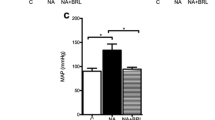Summary
Ischaemia imposes a progression of damage on the myocardium, starting with a loss of adenosine triphosphate, creatine phosphate, potassium and active tension-generating capacity. These changes progress until the tissue is incapable of maintaining ionic homeostasis, is depleted of purine precursors and shows evidence of structural disorganization. Upon reperfusion the ischaemia-induced damage is exaggerated, primarily because of the accompanying uncontrolled gain in calcium, increasing tissue osmolarity and release of endogenous noradrenaline. When used prophylactically, calcium antagonists attenuate many of the deleterious effects of ischaemia and reperfusion. We have previously shown that long-term administration of verapamil to rats (50 mg/kg daily, orally) depletes their cardiac stores of noradrenaline (NA) (3.9 ± 0.3 μg/g dry wt in controls vs 0.9 ± 0.1 μg/g dry wt NA after 6 weeks of therapy). This loss of NA was not accompanied by a change in β1-adrenoceptor density (35.5 ± 1.9 fmol/mg protein for controls vs 31.2 ± 2.3 fmol/mg protein after 6 weeks of therapy). Verapamil withdrawal after 6 weeks of therapy resulted in a restoration of ventricular NA levels; within 2 days they had recovered to 75% of their original values. The density of the β1-adrenoceptor was unaltered. Withdrawal of verapamil results in rapid repletion of cardiac NA, with an initial but transient reduction in β1-adrenoceptor density. The absence of β1-adrenoceptor “up-regulation” under these conditions probably contributes to the absence of withdrawal problems upon cessation of verapamil therapy.
Similar content being viewed by others
References
Aceto JF, Kitzen J, Raffa RB, Tallarida RJ (1985) Altered vascular responsiveness to norepinephrine following withdrawal of verapamil in rabbits. J Cardiovasc Pharmacol 7: 1011–1012
Dillon JS, Nayler WG (1987) [3H]-Verapamil binding to rat cardiac sarcolemmal membrane fragments: an effect of ischaemia. Br J Pharmacol 90: 90–109
Glaubiger G, Tsai BS, Lefkowitz RJ, Weiss B, Johnson EM (1978) Chronic guanethidine treatment increases cardiac β-adrenergic receptors. Nature 273: 240–242
Harapat SR, Kates RE (1980) High performance liquid chromatographic analysis of verapamil. Simultaneous quantification of verapamil and its active metabolite, norverapamil. J Chromatogr 181: 484–489
Kay R, Blake J, Rubin D (1982) Possible coronary spasm rebound to abrupt nifedipine withdrawal (letter). Am Heart J 103: 308
Limas CL, Limas C (1984) Rapid recovery of cardiac β-adrenergic receptors after isoproterenol-induced down-regulation. Circ Res 55: 524–531
Lowry OH, Rosebrough NH, Farr AL, Randall RJ (1951) Protein measurement with the folin phenol reagent. J Biol Chem 193: 265–279
McPherson GA (1983) A practical computer based approach to the analysis of radioligand binding experiments. Comput Programs Biomed 17: 107–114
Mickey J, Tate R, Lefkowitz RJ (1975) Subsensitivity of adenylate cyclase and decreased β-adrenergic receptor binding after chronic exposure to ( - )isoproterenol in vitro. J Biol Chem 250: 5727–5729
Mysliwiec M, Rydzewski A, Bulhak W (1983) Calcium antagonist withdrawal syndrome. Br Med J 286: 1898
Nayler WG (1988) Calcium antagonists. Academic Press, London, pp 157–249
Nayler WG, Dillon JS, Sturrock WJ, Buckley DJ (1988) Effect of chronic verapamil therapy on cardiac norepinephrine and β-adrenoceptor density. J Cardiovasc Pharmacol 12: 629–636
Nelson DO, Mangel AW, Graham CA (1984) Altered human vascular activity following withdrawal from calcium channel blockers. J Cardiovasc Pharmacol 6: 1249–1250
Skattebol A, Triggle DJ (1986) 6-Hydroxydopamine treatment increases β-adrenoceptors and Ca+ channels in rat heart. Eur J Pharmacol 127: 287–289
Subramanian VB, Boules MJ, Khurmi NS, Davies AB, O'Hara MJ, Raftery EB (1983) Calcium antagonist withdrawal syndrome: objective demonstration with frequency-modulated ambulatory ST segment monitoring. Br Med J 286: 520–521
Tenner TE, Mukherjee A, Kelly-Hester R (1982) Resperine-induced supersensitivity and the proliferation of cardiac β-adrenoceptors. Eur J Pharmacol 77: 61–65
Wallenstein S, Zucker CI, Fleiss JL (1980) Some statistical methods useful in circulation research. Circ Res 47: 1–9
Williams HT, Lefkowitz RJ, Watanabe AM, Hathaway DR, Besch JR (1977) Thyroid hormone regulation of beta-adrenergic receptor number. J Biol Chem 252: 2787–2789
Author information
Authors and Affiliations
Rights and permissions
About this article
Cite this article
Nayler, W.G., Dillon, J.S. Effect of verapamil withdrawal on cardiac β1-adrenoceptor density. Eur J Clin Pharmacol 39, S13–S16 (1990). https://doi.org/10.1007/BF01409201
Issue Date:
DOI: https://doi.org/10.1007/BF01409201




